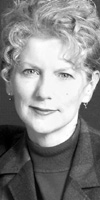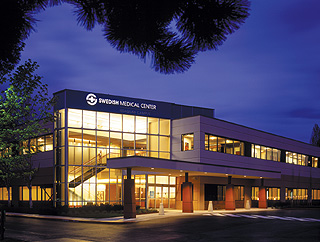
DJC.COM
November 16, 2006
Quick! Turn an office building into a medical center
Callison

Faulkner
|
With the release of three reports by the Washington D.C.-based Institute of Medicine last summer, the rest of America learned what the health care industry has known for some time: emergency departments are in a nationwide crisis.
The product of a two-year analysis of the nation’s emergency care system, the reports conclude that the system has been pushed to the verge of collapse by too few hospital beds and too many uninsured or under-insured patients using the emergency department as their primary source of health care. It’s a problem that many industry leaders and politicians are trying to address before faced with a devastating emergency.
Meanwhile, emergency departments have become the nation’s most expensive waiting rooms, which is exactly what Seattle’s Swedish Medical Center wanted to avoid in building Washington state’s first freestanding emergency department in Issaquah.
Rising to the challenge

Photo by Chris Eden/Callison Architects developed a faster design process for the Swedish Eastside Specialty Center, the state’s first freestanding emergency department, in a former Issaquah office building. |
Swedish had only 11 months to design and construct the facility, which, they specified, must offer a patient-centered, no-wait experience.
Designing a no-wait, freestanding emergency department, which had no precedent in Washington state, is a tall order by any standard. Pulling it off in less than a year — in a former office building — would be a Herculean feat.
Absent the luxury of time, we did what any good doctor would do in an emergency: we triaged the situation.
The project’s constraints — freestanding, no-wait, fast track, adaptive reuse, tight budget — forced us to abandon typical assumptions about how to design.
In response to these multiple, tight parameters, we intensified our approach, accelerating our design process.
We yielded not only a uniquely patient-centered, freestanding facility, but two inspiring by-products: a new emergency department planning concept and a new way of designing that has since become a fixture of our practice.
A shorter wait
Today, Swedish Eastside Specialty Medical Center guarantees that patients will see a physician in 30 minutes or fewer, with most being seen within 10 minutes.
This guarantee, coupled with the emergency department’s environment, has increased care team effectiveness and continues to fuel patient satisfaction. It has given Swedish a stake in Seattle’s Eastside suburban market, which was 60 percent greater than projections for the first month.
Instead of the typical emergency department plan, which begins with a large waiting room and proceeds to a single path for the care team, patients and their families, the new plan eliminates the waiting room and separates the circulation paths of the family and care team.
Both parties meet at only one point: over the patient. Patient rooms are also standardized and enlarged. The concept increases patient control and privacy while reducing care team distractions to improve the safety and effectiveness of care.
New design process
The solution also resulted in a new way of working for the Callison team. The accelerated process that got us there, what we now call Architectural Improv, was so successful at generating strong ideas and group buy-off, we now rely on it regularly.
Here’s how it works:
Set the scene. First, we establish the basics of who, what, where, when and why. Key players representing every aspect of facility-related health care delivery are identified. As a group, we document existing flows of people, process and materials (the real) against desired outcomes (the ideal) to provide a baseline of information as well as a target to design toward.
Assign roles. We assigned roles and stuck to them like glue. For example, I represented only the human point of view, and thus banished all thoughts of budget, schedule, care teams or administrators that might compromise my perspective.
Other team members were accountable for those and other perspectives, such as materials management, information technology and diagnostic imaging.
Enjoy the show. This isolation of roles had a remarkable effect: In the midst of a frenzied schedule, it gave each team member space to think.
Filters disappeared. Ideas emerged undiluted. Everyone, including the client, who also participated, had a say. Expectations were aligned. Decisions were made without going back.
And before long, an innovative concept took shape that would literally take the wait out of the emergency department.
The mental elbowroom and clarity we gained were two extraordinary benefits we couldn’t have predicted achieving in a process developed purely as a time saver.
Reflecting on why it happened and how to replicate it we realized that, yes, the urgency of this project’s schedule forced everyone on the team to give up a part of themselves in the name of a larger goal. But the real lesson, as I see it, rests not so much in the sacrifice itself, but that in giving some things up, we gained far more than we could have imagined.
Giant leap forward
Approaching the Eastside Specialty Center in a nontraditional way required a giant leap forward to redefine the emergency department experience as a more efficient and humane event.
Will it solve the emergent care crisis? No, although I know it will do much to resolve the operational, image and medical challenges associated with overcrowding in this specific community.
But our discovery demonstrates an important point that will be critical as leaders work on the far more urgent need to overhaul a badly compromised system: We can’t expect new ideas to emerge from old ways of thinking. We need to step out of our everyday roles to gain perspective and insight. And sometimes, all we need is a little space.
Janet Faulkner is an expert in the design of health care environments and is a leader of the health care design practice at Callison.
Other Stories:
- Hospital gardens help patients heal
- New law encourages hospitals to give patients a lift
- Hotels offer lessons for Oregon hospital
- State to adopt national health care design standards
- Complex projects call for virtual construction
- Build a better building with 3-D modeling
- Boomers shaping future of health care design
Copyright ©2009 Seattle Daily Journal and DJC.COM.
Comments? Questions? Contact us.